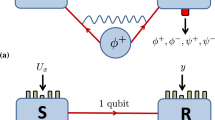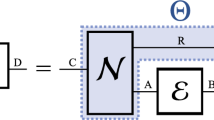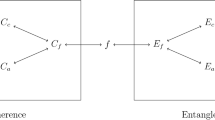Abstract
Quantum information provides fundamentally different computational resources than classical information. We prove that there is no unitary protocol able to add unknown quantum states belonging to different Hilbert spaces. This is an inherent restriction of quantum physics that is related to the impossibility of copying an arbitrary quantum state, i.e., the no-cloning theorem. Moreover, we demonstrate that a quantum adder, in absence of an ancillary system, is also forbidden for a known orthonormal basis. This allows us to propose an approximate quantum adder that could be implemented in the lab. Finally, we discuss the distinct character of the forbidden quantum adder for quantum states and the allowed quantum adder for density matrices.
Similar content being viewed by others
Introduction
Addition plays a central role in mathematics and physics, while adders are ubiquitous devices in the fields of computation1 and electronics2. In this sense, usual sum operations can be realized by classical Turing machines3 and also, with a suitable algorithm, by quantum Turing machines4,5. Furthermore, the sum of known state vectors in the same Hilbert space, i.e. quantum superposition, is at the core of quantum physics. In fact, entanglement and the promised exponential speed-up of quantum computing are based on such linear combinations. Here, we consider the existence of a quantum adder, defined as a unitary operation mapping two unknown quantum states encoded in different quantum systems onto their sum codified in a single system. The surprising answer is that this quantum adder is forbidden and it has the quantum cloner as a special case6. This no-go result, as other prohibited operations6,7,8,9, is of fundamental nature and its implications should be further studied. Furthermore, we consider a high-fidelity approximate quantum adder involving ancillary systems. Recently, we have known about a parallel work analyzing a similar problem, in which an optimal approximate quantum adder was found10.
Let  be two quantum states of a finite-dimensional Hilbert space. The conjectured quantum adder, sketched in Fig. 1, would be a mathematical operation defined as the unitary
be two quantum states of a finite-dimensional Hilbert space. The conjectured quantum adder, sketched in Fig. 1, would be a mathematical operation defined as the unitary  , for every pair of unknown
, for every pair of unknown  and ancillary vector
and ancillary vector  ,
,

where the ancillary state  may depend on the input states. There are several ways of proving the unphysicality of Eq. (1). The simplest one is to note that the unobservable global phase on its l.h.s. could be distributed in infinite forms on its r.h.s.,
may depend on the input states. There are several ways of proving the unphysicality of Eq. (1). The simplest one is to note that the unobservable global phase on its l.h.s. could be distributed in infinite forms on its r.h.s.,  , with ϕ = ϕ1 + ϕ2, yielding an observable relative phase. When the ancillary state
, with ϕ = ϕ1 + ϕ2, yielding an observable relative phase. When the ancillary state  does not depend on the input quantum states, the (forbidden) quantum cloner becomes a particular case of this restricted quantum adder. This follows from applying U to two equal state vectors
does not depend on the input quantum states, the (forbidden) quantum cloner becomes a particular case of this restricted quantum adder. This follows from applying U to two equal state vectors  , since the inverse would generate a quantum cloning operation. Therefore, although the general case of the quantum adder is not equivalent to a quantum cloner, it is still forbidden.
, since the inverse would generate a quantum cloning operation. Therefore, although the general case of the quantum adder is not equivalent to a quantum cloner, it is still forbidden.
We consider now a different question, whether a quantum adder may exist for a given orthonormal basis. In this case, as we will see, the global phase does not produce any ambiguity in the equations. Let us consider the action of the unitary operator  onto a set of orthonormal vectors:
onto a set of orthonormal vectors:  and
and  , with
, with  . Hence, as U is a unitary matrix, it imposes some orthogonality conditions on the final vectors,
. Hence, as U is a unitary matrix, it imposes some orthogonality conditions on the final vectors,  and
and  , with
, with  . The second subspace has dimension d, but these constraints require the existence of at least 2d − 1 orthonormal vectors, which is impossible.
. The second subspace has dimension d, but these constraints require the existence of at least 2d − 1 orthonormal vectors, which is impossible.
We propose now the use of an ancillary system  , which will assure the physicality and experimental feasibility of an approximate quantum adder for arbitrary unknown quantum states, see Fig. 2. This particular adder, Ua, computes the exact sum of the basis elements in qubit systems. Moreover, Ua is extended by linearity to the whole Hilbert space and implements an approximate sum when the input states are superpositions of the basis elements. The adder is given by the following expression in which
, which will assure the physicality and experimental feasibility of an approximate quantum adder for arbitrary unknown quantum states, see Fig. 2. This particular adder, Ua, computes the exact sum of the basis elements in qubit systems. Moreover, Ua is extended by linearity to the whole Hilbert space and implements an approximate sum when the input states are superpositions of the basis elements. The adder is given by the following expression in which  are orthonormal and
are orthonormal and  .
.

Fidelity of the proposed approximate quantum adder.
The fidelity is depicted as a function of the parameters of the input states  , wherej = 1,2. Here, a) ϕ1 = ϕ2 = 0, b) ϕ1 = ϕ2 = π/4, c) ϕ1 = ϕ2 = π/2 and d) θ1 = θ2 = π/4. Note that the diagonal line of each plot corresponds to the approximate quantum cloner that is related to our restricted quantum adder. In this case, the fidelities are the lowest.
, wherej = 1,2. Here, a) ϕ1 = ϕ2 = 0, b) ϕ1 = ϕ2 = π/4, c) ϕ1 = ϕ2 = π/2 and d) θ1 = θ2 = π/4. Note that the diagonal line of each plot corresponds to the approximate quantum cloner that is related to our restricted quantum adder. In this case, the fidelities are the lowest.
Although this approximate quantum adder shows high fidelities, it is not optimal as the one recently found in Ref. 10.
Beyond the sum of quantum states in Eq. (1), we may also consider the statistical addition of density matrices. Here, the input states are the tensor product of any pair of density matrices  , while the output state is the statistical sum
, while the output state is the statistical sum  . The Kraus operators of the quantum channel realizing this adder are given by
. The Kraus operators of the quantum channel realizing this adder are given by  and
and  , with 1 ≤ i, j ≤ d. These operators straightforwardly perform the sum, i.e.,
, with 1 ≤ i, j ≤ d. These operators straightforwardly perform the sum, i.e.,  . Moreover, properly modified Kraus operators allow us to extend the previous result to any convex combination of input states. Therefore, the considered addition of density operators is always possible.
. Moreover, properly modified Kraus operators allow us to extend the previous result to any convex combination of input states. Therefore, the considered addition of density operators is always possible.
Let us compare the adders for state vectors and density operators. By writing the input states in Eq. (1) as density matrices,  , both adders yield
, both adders yield

By comparing the adders in Eq. (3), we can infer that the one in Eq. (1) would require the knowledge of the sum coherences, which were supposed unknown. The nonexistence of a quantum adder is of fundamental character in quantum physics, comparable and deeply related to the no-cloning theorem.
Additional Information
How to cite this article: Alvarez-Rodriguez, U. et al. The Forbidden Quantum Adder. Sci. Rep. 5, 11983; doi: 10.1038/srep11983 (2015).
References
Sipser, M. Introduction to the Theory of Computation (Cengage Learning, 2012).
Bugg, D. V. Electronics: Circuits, Amplifiers and Gates (CRC Press, 2006).
Turing, A. On computable numbers, with an application to the Entscheidungsproblem. Proc. London Math. Soc. 42, 230–265 (1936).
Vedral, V., Barenco, A. & Ekert, A. Quantum networks for elementary arithmetic operations. Phys. Rev. A 54, 147–153 (1996).
Deutsch, D. Quantum Theory, the Church-Turing Principle and the Universal Quantum Computer. Proc. Roy. Soc. London 400, 97–117 (1985).
Wootters, W. K. & Zurek, W. H. A single quantum cannot be cloned. Nature 299, 802–803 (1982).
Nielsen, M. A. & Chuang, I. L. Programmable Quantum Gate Arrays. Phys. Rev. Lett. 79, 321–324 (1997).
Pati, A. K. General impossible operations in quantum information. Phys. Rev. A 66, 062319 (2002).
Kumar, K. S. & Paraoanu, G. S. A quantum no-reflection theorem and the speeding up of Grover’s search algorithm. EPL 93, 20005 (2011).
Oszmaniec, M., Grudka, A., Horodecki, M. & Wójcik, A. Creation of superposition of unknown quantum states. arXiv preprint 1505.04955 (2015).
Acknowledgements
The authors acknowledge support from Spanish MINECO FIS2012-36673-C03-02; Ramón y Cajal Grant RYC-2012-11391; UPV/EHU UFI 11/55 and EHUA14/04, Basque Government IT472-10 and BFI-2012-322; CCQED, PROMISCE, SCALEQIT EU projects.
Author information
Authors and Affiliations
Contributions
U.A.-R. made the calculations while U.A.-R., M.S., L.L. and E.S. developed the protocol and wrote the manuscript.
Ethics declarations
Competing interests
The authors declare no competing financial interests.
Rights and permissions
This work is licensed under a Creative Commons Attribution 4.0 International License. The images or other third party material in this article are included in the article’s Creative Commons license, unless indicated otherwise in the credit line; if the material is not included under the Creative Commons license, users will need to obtain permission from the license holder to reproduce the material. To view a copy of this license, visit http://creativecommons.org/licenses/by/4.0/
About this article
Cite this article
Alvarez-Rodriguez, U., Sanz, M., Lamata, L. et al. The Forbidden Quantum Adder. Sci Rep 5, 11983 (2015). https://doi.org/10.1038/srep11983
Received:
Accepted:
Published:
DOI: https://doi.org/10.1038/srep11983
This article is cited by
-
Optimized quantum implementation of novel controlled adders/subtractors
Quantum Information Processing (2023)
-
Genuine quantum networks with superposed tasks and addressing
npj Quantum Information (2021)
-
Generalized quantum no-go theorems of pure states
Quantum Information Processing (2018)
-
Quantum Adder for Superposition States
International Journal of Theoretical Physics (2018)
-
Protected State Transfer via an Approximate Quantum Adder
Scientific Reports (2017)
Comments
By submitting a comment you agree to abide by our Terms and Community Guidelines. If you find something abusive or that does not comply with our terms or guidelines please flag it as inappropriate.





 and
and  , while the outputs are proportional to the sum,
, while the outputs are proportional to the sum,  with an ancillary state
with an ancillary state  .
.